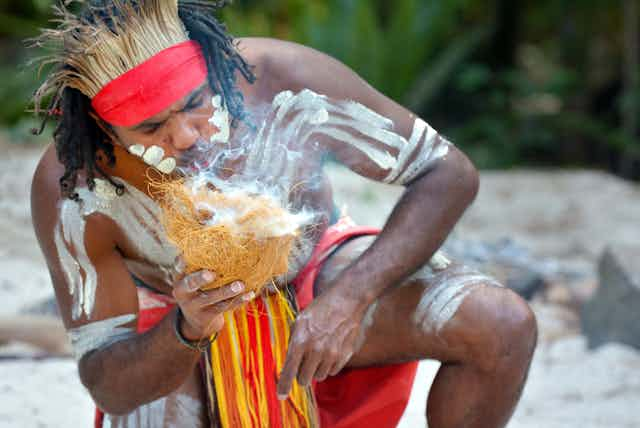The Albanese government is embarking on a suite of environmental reforms: beefing up Australia’s carbon credit scheme, and establishing a market to fund environmental restoration. These big policy changes may seek to justify colonial practices imposed on First Nations people and their country.
Both reforms require land owned by Indigenous Australians. First Nations peoples hold tenure over 54% of Australia’s landmass – including native title and freehold, and other interests such as pastoral leases. First Nations people also manage almost half of Commonwealth parks and reserves.
The global response to the climate crisis will require a great deal of land, including for carbon abatement and nature repair. But First Nations people cannot be locked away from this land. They must be allowed to benefit from it, in a way that’s environmentally and economically sustainable.
And land needs people to care for it – to reduce the risk of destructive bushfires, control weeds and feral animals, and improve soil health.
First Nations people should have a real say in decisions affecting them and their Country. Here, we look at how the above policy-making efforts measure up.

The Chubb review: a welcome sign of progress
The independent Chubb Review of Australia’s carbon credit system was released in December. The review, commissioned by the Albanese government, investigated the issuing of credits under the Emissions Reduction Fund, a national scheme to reduce greenhouse gas emissions.
In a welcome acknowledgement, the review stated:
First Nations Australians hold deep knowledge and understanding of Healthy Country, informed by thousands of years of observation and stewardship of local ecosystems, and passed down through many generations.
The review called for a number of substantial changes, including several involving First Nations rights. We believe these measures, if implemented, will strengthen the carbon industry and First Nations engagement in the carbon economy.
Significantly, the review reiterated that First Nations Australians people should to participate in and benefit from the carbon credit scheme – a concept known as “core benefits”.
Core benefits occur when a project leads to carbon abatement, and delivers environmental, social, cultural and employment benefits to First Nations people and others.
The long overdue principle of free, prior and informed consent has now also been adopted. This includes removing the option to conditionally register carbon abatement projects on Native Title lands before consent is granted.
The review also recommends that at least one member of an important new committee be a First Nations Australian with relevant experience. This is a welcome development, although it begs the question: why just one?
To properly reflect the importance of First Nations land and knowledge, surely at least half the members on important committees should be First Nations people.

Nature repair market: room for improvement
Another major national reform on the cards is the Nature Repair Market Bill. The legislation, if passed, would establish a scheme whereby landholders who restore or manage habitat would be rewarded with “certificates” which can then be sold on a market.
A fact sheet accompanying the bill highlights the importance of First Nations knowledge. And we welcome the requirement for consent from native titleholders for any project.
Unfortunately, though, the bill fails to build in an Indigenous understanding of land management.
For example, it does not include a mechanism to measure “core benefits” as described above – nor does it provide a framework for Indigenous-led verification of the environmental, social and cultural values associated with community and economic development programs.
Additionally, only one position on the Nature Repair Market Committee is made available to a person “with Indigenous Knowledge”.
These are serious failings. As a group of experts said in a submission to the recent royal commission into natural disasters, First Nations people have managed Australian landscapes for more than 65,000 years using highly effective holistic land management practices. As the submission stated, these methods:
have been the result of intimate knowledge of Country developed over many, many millennia of careful observation, continual interaction and active custodianship.
The best known example of this knowledge is “cultural burning” – the First Nations practice of burning Country for environmental, cultural and regenerative benefits.
All Australians benefit when First Nations people contribute their highly nuanced land management expertise to climate and environmental protection schemes.
The bill has missed an opportunity to draw on First Nations expertise in improving biodiversity and healing our climate. To address this, it must draw on the wealth of First Nations knowledge and experience of managing Country. This requires putting Indigenous decision-making at the centre of the policy’s development.
Read more: Friday essay: how ancient beliefs in underwater worlds can shed light in a time of rising sea levels

Eradicating eco-colonialism
There’s currently much talk about the need to involve First Nations people when devising policy reform. In policy circles, this is known as “co-design”.
In our experience, however, the process usually involves only superficial amendments so a policy appears to include Indigenous ways of knowing, being and doing – yet allowing the dominant Western framework to persist. All too often, the resulting policy does not serve the interests or reflect the knowledge of First Nations people.
At worst, the Aboriginal art on the cover of a policy document may be the only expression of “co-design”. A stench of tokenism persists. We call this the “eco-colonial elephant in the room”.
Instead, governments and First Nations people should share decision-making in a process in which Indigenous and non-Indigenous worldviews have equal billing.
Because when it comes to tackling the most pressing environmental issues of our time, we must embrace an “us and us” ideology that draws on the best ideas and most valuable experiences – locking the eco-colonial elephant out of the room once and for all.
Read more: 65,000-year-old plant remains show the earliest Australians spent plenty of time cooking

